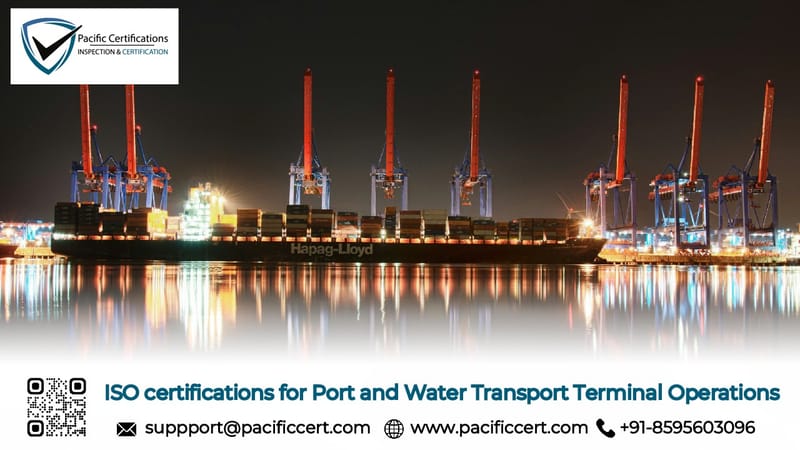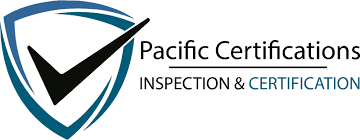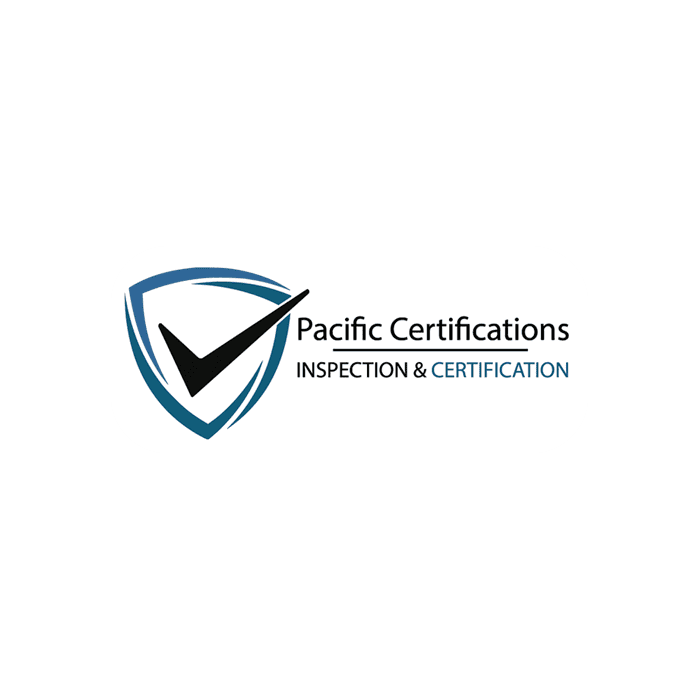ISO Certifications for Port and Water Transport Terminal Operations, Requirements and Benefits

Introduction
Ports and water transport terminals are where global trade comes to life. Every day, thousands of containers carrying food, electronics, machinery, and raw materials are loaded and unloaded, while ferries and cruise ships move passengers across regions. These facilities are not just transit points, they are the places where supply chains succeed or stall.
Because of this, port operators work under constant pressure. They need to move cargo quickly without compromising worker safety, deal with rising fuel and energy costs, comply with environmental regulations, and handle growing security risks. The International Maritime Organization (IMO) estimates that more than 80% of world trade by volume moves by sea, which shows just how central ports are to the global economy. As volumes increase and regulations tighten, many operators are now looking to ISO certifications to show that they run safe, reliable, and sustainable operations.
Get your certification process started today, contact us today at [email protected]
Ports and water terminals are the backbone of global trade. ISO certifications give these facilities the structure to operate safely, efficiently, and sustainably.
Quick Summary
ISO certifications help ports and water transport terminals manage safety, quality, and sustainability in a complex industry. The key standards are ISO 9001 (quality), ISO 14001 (environment), ISO 45001 (safety), ISO 28000 (supply chain security), and ISO 22301 (business continuity). Certification builds confidence with shipping companies, regulators, and customers while supporting sustainable and secure port operations.
Applicable ISO Standards for Port and Water Transport Terminal Operations
Several ISO standards are directly relevant to the operations of ports and water transport terminals. Below are some of the key ISO standards applicable to this sector:
Standard | Focus Area | Relevance |
|---|---|---|
ISO 9001:2015 | Quality Management | Ensures consistency in terminal operations, documentation, and customer service. |
ISO 14001:2015 | Environmental Management | Helps reduce emissions, manage waste, and protect marine ecosystems. |
ISO 45001:2018 | Occupational Health & Safety | Protects workers in high-risk environments such as docks, cranes, and warehouses. |
ISO 28000:2022 | Supply Chain Security | Strengthens cargo security and reduces risks of smuggling or terrorism. |
ISO 22301:2019 | Business Continuity | Keeps ports operational during crises such as strikes, natural disasters, or cyberattacks. |
ISO/IEC 27001:2022 | Information Security | Secures digital systems, port management software, and shipping data. |
ISO 50001:2018 | Energy Management | Improves efficiency in fuel and electricity use at terminals. |
ISO 20121:2012 | Sustainable Event Management | Relevant for ports hosting large-scale exhibitions, maritime events, or cruise terminals. |
ISO 9001:2015 - Quality Management Systems
ISO 9001:2015 sets the criteria for a quality management system and is based on several quality management principles, including a strong customer focus, the motivation and implication of top management, the process approach, and continual improvement.
ISO 14001:2015 - Environmental Management Systems
ISO 14001:2015 provides a framework for organizations to manage their environmental responsibilities systematically. For ports and terminals, this includes managing the environmental impacts of their operations, such as pollution control, waste management, and energy efficiency.
ISO 45001:2018 - Occupational Health and Safety Management Systems
ISO 45001:2018 focuses on reducing occupational injuries and diseases in the workplace. In the context of port and terminal operations, this standard is crucial due to the high-risk nature of the industry.
ISO 28000:2007 - Security Management Systems for the Supply Chain
ISO 28000:2007 specifies the requirements for a security management system, particularly in relation to security assurance in the supply chain. For ports and water transport terminals, this standard is essential for managing security risks, such as theft, terrorism, and other threats, ensuring the secure and efficient movement of goods.
ISO 55001:2014 - Asset Management Systems
ISO 55001:2014 provides a structured framework for managing the life cycle of assets. For ports, this includes managing physical infrastructure, equipment, and other assets crucial to operations.
ISO 22301:2019 - Business Continuity Management Systems
ISO 22301:2019 outlines the requirements for a business continuity management system, helping organizations prepare for, respond to, and recover from disruptive incidents.
ISO 31000:2018 - Risk Management
ISO 31000:2018 provides guidelines for risk management, enabling organizations to identify, assess, and manage risks systematically. For ports and terminals, this standard is essential for managing operational risks, ensuring safety, and maintaining resilience against unforeseen events.
ISO 50001:2018 - Energy Management Systems
ISO 50001:2018 focuses on improving energy performance, including energy efficiency, use, and consumption. Given the energy-intensive nature of port operations, ISO 50001 helps operators manage their energy consumption more efficiently, reduce costs, and minimize environmental impact.
Click here to find out more applicable standards to your industry
Looking for ISO certification for your Port and Water Transport Terminal Operations? We're here to help. Email us at [email protected].
What are the requirements of ISO Certifications for Port and Water Transport Terminal Operations?
To achieve ISO certification for any of the standards relevant to port and water transport terminal operations, organizations must meet specific requirements. Below is an overview of the key requirements for each of the mentioned ISO standards:
General requirements:
- Clear identification of services, such as container handling, passenger services, logistics, or storage facilities.
- Written commitments to safety, environmental protection, quality, and data security.
- Identifying hazards such as workplace accidents, oil spills, cyber threats, and supply chain interruptions.
- Standardizing operations for cargo handling, customs clearance, vessel coordination, and emergency response.
- Equipping staff with skills in crane operation, safety measures, hazardous material handling, and incident management.
- Maintaining logs of cargo throughput, inspections, safety drills, and compliance reports.
- Tracking KPIs such as turnaround times, accident rates, equipment downtime, and emissions levels.
- Regular checks by management to ensure systems remain effective and up to date.
Specific requirements:
ISO 9001:2015 - Quality Management Systems requirements
- Context of the Organization: Understanding the organization and its context, including the internal and external issues that affect its ability to achieve intended results.
- Leadership: Top management must demonstrate leadership and commitment by establishing a quality policy, setting objectives, and ensuring the QMS is integrated into business processes.
- Planning: Identifying risks and opportunities that could impact the QMS and planning actions to address them. This includes setting quality objectives and planning changes to the QMS.
- Support: Providing necessary resources, ensuring competence, awareness, communication, and maintaining documented information (e.g., procedures, records).
- Operation: Establishing, implementing, and controlling processes needed to meet product/service requirements, including design, production, and delivery processes.
- Performance Evaluation: Monitoring, measuring, analyzing, and evaluating the QMS performance through internal audits and management reviews.
- Improvement: Taking actions to improve the QMS, including managing nonconformities, corrective actions, and continuous improvement initiatives.
ISO 14001:2015 - Environmental Management Systems requirements
- Context of the Organization: Identifying environmental aspects, legal and regulatory requirements, and the needs and expectations of interested parties.
- Leadership: Commitment from top management to environmental management, including establishing an environmental policy and ensuring integration with business processes.
- Planning: Identifying environmental risks and opportunities, setting environmental objectives, and planning how to achieve them. This includes life cycle perspectives and considering environmental impacts of activities, products, and services.
- Support: Providing resources, ensuring competence, training, and communication related to the EMS. This includes maintaining necessary documentation.
- Operation: Implementing operational controls to manage significant environmental aspects, including emergency preparedness and response procedures.
- Performance Evaluation: Monitoring, measuring, and evaluating environmental performance, conducting internal audits, and reviewing compliance with legal and other requirements.
- Improvement: Continual improvement of the EMS by taking corrective actions and addressing nonconformities.
ISO 45001:2018 - Occupational Health and Safety Management Systems requirements
- Context of the Organization: Understanding the organization's external and internal issues, legal requirements, and the needs and expectations of workers and other stakeholders.
- Leadership and Worker Participation: Top management must take responsibility for the OH&S management system, establish an OH&S policy, and ensure active participation of workers at all levels.
- Planning: Identifying hazards, assessing risks, and determining opportunities to prevent harm. Setting OH&S objectives and planning how to achieve them.
- Support: Providing the necessary resources, competence, and training for OH&S, ensuring effective communication, and maintaining documented information.
- Operation: Implementing controls to manage OH&S risks, including managing change and emergency preparedness.
- Performance Evaluation: Monitoring and measuring OH&S performance, conducting internal audits, and reviewing compliance with legal requirements.
- Improvement: Taking corrective actions to address incidents and nonconformities, and continually improving the OH&S management system.
ISO 28000:2007 - Security Management Systems for the Supply Chain requirements
- Security Management Policy: Establishing a security management policy that reflects the organization's commitment to managing security risks.
- Risk Assessment and Management: Conducting risk assessments to identify potential security threats and vulnerabilities within the supply chain and developing plans to mitigate these risks.
- Security Management Objectives: Setting security objectives that are consistent with the security policy and managing them effectively.
- Roles and Responsibilities: Defining roles, responsibilities, and authorities related to security management within the organization.
- Operational Controls: Implementing procedures to control security risks in daily operations, including access control, information security, and physical security measures.
- Monitoring and Measurement: Continuously monitoring and measuring security performance to ensure that the security management system remains effective.
- Incident Management: Establishing procedures for responding to security incidents and nonconformities, including corrective actions and improvements.
- Internal Audits: Conducting regular internal audits to assess compliance with the security management system and identify areas for improvement.
ISO 50001:2018 - Energy Management Systems requirements
- Energy Policy: Developing an energy policy that demonstrates the organization’s commitment to improving energy performance.
- Energy Planning: Conducting an energy review to analyze energy use and consumption, identify areas for improvement, and establish energy baselines.
- Energy Objectives and Targets: Setting measurable energy objectives and targets that align with the organization’s energy policy.
- Support: Providing the necessary resources, ensuring competence, raising awareness, and maintaining documented information related to the EnMS.
- Operational Control: Implementing processes and procedures to control and optimize energy use, including energy-efficient design and procurement.
- Monitoring, Measurement, and Analysis: Regularly monitoring and measuring energy performance, comparing it to the energy baseline, and taking corrective actions as needed.
- Internal Audits: Conducting internal audits to assess the effectiveness of the EnMS and identify areas for improvement.
- Management Review: Top management must review the EnMS to ensure it is effective, aligned with the organization’s energy policy, and identify opportunities for improvement.
- Continual Improvement: Implementing actions to continually improve energy performance and the effectiveness of the EnMS.
Tip: Ports should begin with ISO 9001 for quality management, followed by ISO 14001 and ISO 45001 to meet environmental and safety obligations. With increasing digitalization and global security concerns, adding ISO/IEC 27001 and ISO 28000 has become a priority.
Take the first step towards ISO certification for your Port and Water Transport Terminal Operations. Contact Pacific Certifications at [email protected] or +91-8595603096.
What are the benefits of ISO Certifications for Port and Water Transport Terminal Operations?
Certification brings both operational and strategic value:
- Standardized procedures reduce delays and errors in cargo and passenger handling.
- ISO 45001 ensures structured safety systems in environments with heavy machinery and hazardous materials.
- ISO 14001 supports waste management, emissions reduction, and marine ecosystem protection.
- ISO 28000 strengthens cargo integrity and minimizes risks of illegal activities.
- ISO 22301 ensures continuity during strikes, extreme weather, or IT disruptions.
- Certification reassures shipping lines, regulators, and customers of professional and accountable management.
- Certified ports often gain preference in global shipping networks.
- ISO 50001 helps reduce energy consumption across terminal operations.
The maritime logistics sector is changing rapidly. Global container throughput is expected to exceed 950 million TEUs by 2025, driven by trade expansion and larger vessels. This growth increases pressure on ports to handle higher volumes with greater efficiency.
Environmental regulations are reshaping the industry. The IMO’s carbon intensity reduction targets for 2030 are pushing ports to adopt sustainable practices, making ISO 14001 and ISO 50001 critical for compliance.
Digital transformation is also accelerating. Smart ports are adopting IoT sensors, AI-driven scheduling, and blockchain-based customs clearance, which heightens the importance of ISO/IEC 27001 for information security. At the same time, global disruptions, from pandemics to geopolitical tensions — have shown the need for business continuity standards like ISO 22301.
Overall, ports with internationally recognized certifications are better positioned to manage risks, meet regulations, and attract shipping lines in a competitive global market.
How Pacific Certifications can help
Pacific Certifications is accredited by ABIS, we provide auditing and certification services for ports, terminals, and maritime logistics operators. Our audits help organizations demonstrate operational maturity, trade security, environmental responsibility, and digital resilience according to international standards. Certification from Pacific Certifications strengthens competitive advantage in global maritime networks.
Our support includes:
- Accredited certification audits for port and maritime logistics management systems
- Objective evaluation of cargo handling, safety, security, and digital control procedures
- Audit reporting that identifies strengths and improvement opportunities
- Transparent certification decision aligned with international accreditation requirements
- Surveillance assessments to maintain compliance and continual improvement
If you need support with ISO certification for your water transport terminal operations, contact us at [email protected] or +91-8595603096.
Ready to get ISO certified?
Contact Pacific Certifications to begin your certification journey today!
Author: Sony
Suggested Certifications
Read more: Pacific Blogs

